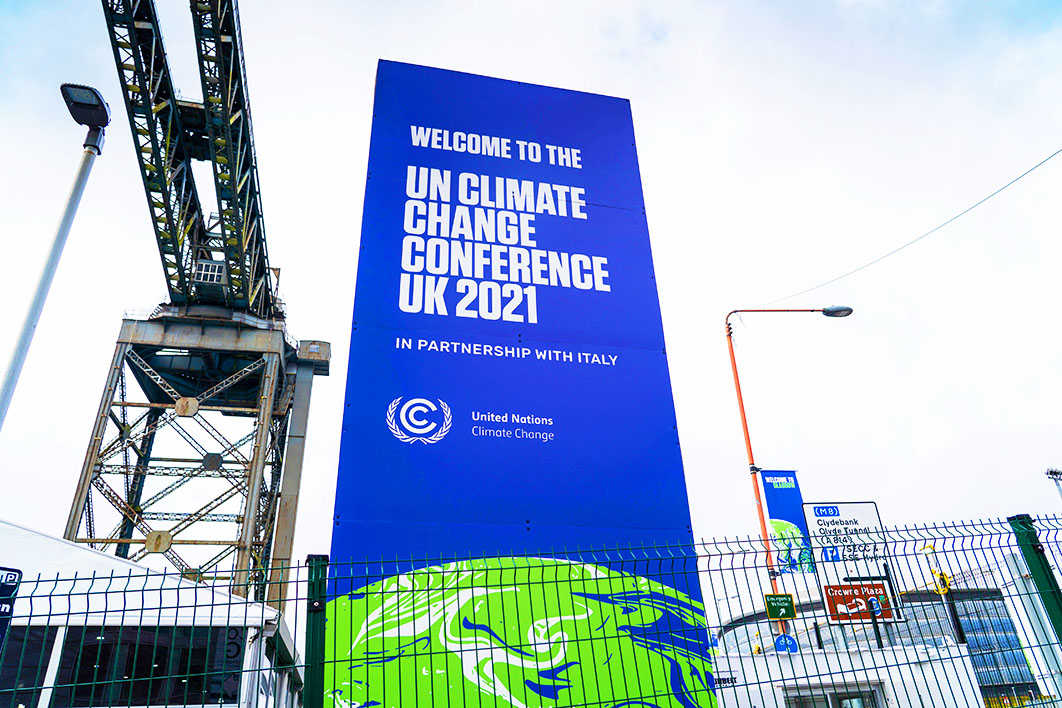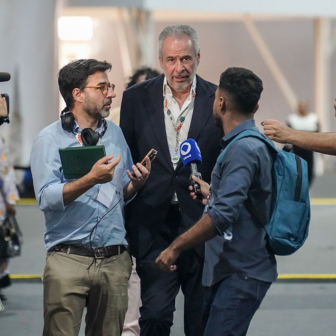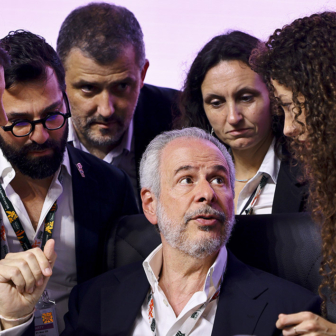World leaders will gather on Monday in Glasgow for the COP26 climate summit. Well, some leaders. At the time of writing it looks like China’s Xi Jinping and Russia’s Vladimir Putin — the world’s first- and fourth-largest carbon polluters — won’t be attending this “last chance” to save the planet. But US president Joe Biden will, along with Scott Morrison and plenty of others, and the eyes of the world will be on them.
COP26 is not the first “last chance,” of course. Several others have been so billed over the past decade or so. But this is indeed an important meeting because it’s the moment specified under the 2015 Paris climate agreement when countries must strengthen their commitments to tackle global heating. After three years of biblical droughts, fires and floods on every inhabited continent — and melting ice sheets on the other — no leader can claim that climate can safely be left to the future.
COP26 must tackle two big issues. The first of these is the gap between the aggregate commitments countries have made to cut their greenhouse gas emissions by 2030, and the total the scientists have said is required to keep global heating to the Paris goal of 1.5°C above pre-industrial levels. To have a reasonable chance of achieving this limit will require global emissions to be around 26 gigatonnes of carbon dioxide equivalent, or GtCO2e, in 2030. Countries’ announced emissions reduction pledges will reduce global emissions to around 46–49 GtCO2e, leaving an emissions gap of 20–23 GtCO2e. Put another way, we are currently on track for an average global temperature rise not of 1.5°C but of 2.4–2.9°C, levels at which the severest climate impacts become certain.
The second issue for COP26 is the finance gap. In Paris the richest countries promised the poorest that they would mobilise US$100 billion a year by 2020 to help them tackle climate change, and more thereafter. At the last count, in 2019, they had raised around US$80 billion. Developing countries have been loud in their protests.
But there’s a problem. Although the emissions and finance gaps are the big issues COP26 must address, neither will actually be negotiated in Glasgow. They are not even on the official agenda for the talks.
How is this possible? To understand it we need to delve into the past, for what might be called the “Glasgow paradox” — that the two most important issues at COP26 will not actually be the subject of its negotiations — has its origins in the turbulent history of UN climate negotiations.
The treaty underpinning these negotiations is the UN Framework Convention on Climate Change, or UNFCCC, agreed at the first Rio Earth Summit in 1992. Just a few years after the first assessment of global warming by the Intergovernmental Panel on Climate Change, or IPCC, it set out an overall goal and some governing principles for how the international community should control emissions and adapt to a warming world. In doing so it made a very clear distinction between developed and developing countries. Countries had “common but differentiated responsibilities”: while all had a general responsibility to act, developed ones — the Western world and Eastern Europe — had the specific obligation to reduce their emissions and provide finance and technological support to developing countries. In 1992 China was still unequivocally “developing.”
These principles were then enacted in the Kyoto Protocol, agreed at COP3 in 1997. The developed countries negotiated how much each would commit to cutting its emissions by 2008–12. (Some, such as Australia, were allowed to increase them.) Developing countries took on voluntary actions only — and insisted that these depended on financial and technological assistance from the rich world.
Kyoto was a landmark agreement, backed by sanctions in international law for non-compliance. But it failed at its first hurdle. Though personally negotiated by US vice-president Al Gore, it attracted not a single vote in the US Senate. America, its legislators agreed, could not accept a treaty in which China did not have the same legal obligation to act.
The emissions reduction targets negotiated under the Kyoto Protocol were largely achieved. But the US’s absence was not acceptable to the European Union, Japan and the rest of the developed country signatories, and they sought to negotiate a new agreement at COP15 in Copenhagen in 2009. Copenhagen foundered, though, when the United States insisted that China — now a rapidly growing “emerging economy” — must take on the same legal obligations to cut its emissions (and to be transparent about reporting them) as it had. China refused, and the negotiations broke down in acrimony and recrimination.
Fast-forward to COP21 in Paris in 2015. A third attempt was being made to agree on an implementing treaty. Now China was the world’s second-largest polluter and a major economic competitor to the United States and the rest of the developed world. Brazil, South Africa, India and other emerging economies had also become major contributors to climate change, and each was now willing to take on emissions reduction commitments. But they weren’t willing to negotiate these with other countries. And they were not prepared to have them made legally binding in international law, with Kyoto-style sanctions for non-compliance.
If the emerging economies wouldn’t do this, nor would the United States, which still insisted on legal parity. So the Paris agreement found a compromise. It set out a new and comprehensive set of rules on how governments should act, including the legal requirement that they must make a “nationally determined contribution” to the global climate process. But it was up to each country to decide for itself what that contribution should be.
The Paris agreement was undoubtedly a breakthrough. For the first time, every country in the world had to tackle its emissions, and to do so in pursuit of a specific temperature goal — limiting heating to “well below” 2°C, with an aspiration to keep it to 1.5°C. The agreement even set a “net zero” goal, albeit for some time in the second half of the century.
But Paris had a huge flaw. The contributions submitted by countries alongside the agreement didn’t add up to the agreed aggregate goal. The emissions gap was born.
Paris has a mechanism designed to patch this up. It requires the IPCC to conduct a “stocktake” of the climate science three years after the agreement, and assess progress so far. And two years after that, countries must return to the table with stronger commitments.
The IPCC duly reported in 2018, with a much starker injunction that global emissions had to be cut by 45 per cent by 2030 to hold heating to 1.5°C. COP26 is now the five-year moment (having been postponed from 2020 because of Covid) when the emissions and finance gaps must be dealt with.
But the Paris compromise still rules. It is still up to individual countries to make their emissions cuts and finance pledges on their own. It is still not the task of the UN climate talks to negotiate these, and still not even the job of countries to discuss with one another what they each should be doing. Hence their absence from the COP agenda.
And despite much stronger commitments, countries are still not doing enough. The United States, the European Union, Britain, Japan and others have all this year strengthened their emissions reduction pledges for 2030, some very dramatically. But the gap to the 1.5°C trajectory remains. Although China and India have not yet announced their contributions (the only major emitters not to have done so), they can’t get near to closing the gap on their own.
So the emissions and finance gaps are what COP26 is primarily about, but neither is on the actual agenda. Of course, the conference will discuss emissions reductions and finance in general, and no doubt bitter speeches from developing countries about the inadequate commitments of the developed world. But there will be nowhere in the talks where the gaps can be narrowed.
So what will be negotiated at COP26? The official agenda is all about the “Paris rulebook,” the task of turning the general principles of the Paris agreement into specific, detailed regulations. Much has already been done in the intervening years, but there are still some major sticking points.
The largest of these is about “carbon markets.” These are the mechanisms by which developed countries, including Australia, and companies hope to be able to buy emissions reductions (such as tree planting) done in developing countries, to save them the difficulty and cost of reducing emissions themselves. Many companies claiming to be committed to acting on climate change (notably in the oil and gas and airline sectors) are expecting to get much of their emissions cut in this way — to the great consternation of climate campaigners, who see such “offsetting” largely as an unsustainable scam. Many developing countries are not happy about carbon markets either, and the Glasgow talks are likely to be tough.
So the Paris rulebook is not insignificant. But it is hard to argue that it is what’s really important. The negotiations over the regulations are highly technical, barely needing ministers, let alone leaders. And they are certainly not what climate activists, the public or the media think COP26 is about.
So how can this mismatch of expectation and reality be overcome? As the COP convenor, the British government hopes to bridge the gap in three ways.
First, it has brought the leaders together (which does not normally happen at COPs) precisely to discuss the shortfalls in emissions cuts and finance. In an ideal world it would be extracting stronger commitments than the assembled presidents and prime ministers have so far announced.
They might — just — achieve this on the finance gap, where recent announcements by the United States and others have offered hope that the US$100 billion promise could finally be achieved, and maintained up to 2025. But it seems extremely unlikely that any major country will improve its emissions pledge. In most cases, these have been painstakingly won in each country’s domestic politics, and no leader will want to reopen the argument at home. With China’s leader absent, the idea of a new “grand bargain” between the great powers looks out of the question, too.
But Britain still hopes that it can at least get the leaders to acknowledge that they’re not doing enough, and to commit conclusively to the 1.5°C goal and to the new goal of achieving net zero emissions by 2050. This certainly looks possible.
Second, Britain hopes to get some “side agreements” in four key areas where emissions need to be brought down. These are on building and financing new coal-fired power stations; slowing deforestation; accelerating the phase-out of petrol and diesel cars; and mobilising trillions of dollars of private finance for investment in green infrastructure and technologies. In each of these areas countries and companies have both been signing up to new commitments. So Britain hopes that “real economy” announcements in these areas will show that genuine progress is being made. It will try to bring these for the first time into the formal declaration at the end of the conference.
Third, Britain will encourage the demand by vulnerable countries that parties to the agreement should come back earlier to review their pledges. Under the Paris agreement this is due in 2025: given the continuing emissions gap, there will be huge pressure to agree an earlier review date, probably 2023.
But even if they are achieved, will these moves assuage the public demand for more urgent and stronger action? It is hard to see how they could. The climate scientists and campaigners — with Greta Thunberg their clear-eyed clarion — will say that it isn’t enough. In the conference hall they will be joined by the most climate-vulnerable countries. It will be hard for the media to report anything else. •




